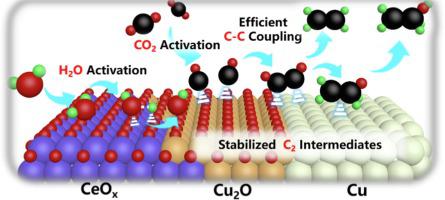当前位置:
X-MOL 学术
›
J. Colloid Interface Sci.
›
论文详情
Our official English website, www.x-mol.net, welcomes your
feedback! (Note: you will need to create a separate account there.)
Highly dispersed Cu-Cu2O-CeOx interfaces on reduced graphene oxide for CO2 electroreduction to C2+ products
Journal of Colloid and Interface Science ( IF 9.4 ) Pub Date : 2024-02-01 , DOI: 10.1016/j.jcis.2024.01.173 Ziyang Zhang 1 , Xin Wang 2 , Hao Tian 2 , Han Jiao 2 , Nana Tian 2 , Lei Bian 2 , Yuan Liu 2 , Zhong-Li Wang 2
Journal of Colloid and Interface Science ( IF 9.4 ) Pub Date : 2024-02-01 , DOI: 10.1016/j.jcis.2024.01.173 Ziyang Zhang 1 , Xin Wang 2 , Hao Tian 2 , Han Jiao 2 , Nana Tian 2 , Lei Bian 2 , Yuan Liu 2 , Zhong-Li Wang 2
Affiliation

|
The Cu-Cu interfaces play a key role in the electrochemical CO reduction reaction (CORR) to produce multi-carbon products (C), however, it is difficult for Cu to exist stably under reducing conditions. Herein, we construct highly dispersed and stable Cu-CuO-CeO interface on reduced graphene oxide (rGO) for CO electroreduction to C products. During the synthesis process, utilizing strong electrostatic interactions, the complex ions of Cu and Ce are uniformly adsorbed on the surface of graphene oxide. Then, under the solvothermal reaction of ethylene glycol and thiourea, the two metal complex ions are converted into highly dispersed and ultrafine CuS-CeO nanocomposites on rGO. Interestingly, CeO and thiourea synergistically regulate the generation of only Cu. Under the CORR process, the reconstruction of CuS promotes the formation of Cu and CuO species. CeO stabilizes partial Cu species and promotes the formation of Cu-CuO-CeO composite interface. With the help of synergistic effect of Cu, Cu and CeO, the optimized reaction interface achieves the Faradaic efficiency (FE) of 74.5 % for C products with the current density of 230 mA cm at −0.9 V versus the reversible hydrogen electrode. In situ attenuate total reflectance-infrared absorption spectroscopy (ATR-IRAS) spectra show that the composite interfaces promote the adsorption and activation of HO and CO, improve the surface coverage of CO intermediates (*CO), and thus accelerate the CC coupling process.
中文翻译:

还原氧化石墨烯上高度分散的 Cu-Cu2O-CeOx 界面用于 CO2 电还原为 C2+ 产物
Cu-Cu界面在电化学CO还原反应(CORR)产生多碳产物(C)中起着关键作用,然而,Cu在还原条件下很难稳定存在。在此,我们在还原氧化石墨烯(rGO)上构建了高度分散且稳定的Cu-CuO-CeO界面,用于CO电还原为C产物。在合成过程中,利用强静电相互作用,Cu和Ce的络离子均匀吸附在氧化石墨烯表面。然后,在乙二醇和硫脲的溶剂热反应下,两种金属络离子在rGO上转化为高度分散的超细CuS-CeO纳米复合材料。有趣的是,CeO和硫脲协同调节Cu的生成。在CO2RR过程中,CuS的重构促进了Cu和CuO物种的形成。 CeO稳定部分Cu物种并促进Cu-CuO-CeO复合界面的形成。借助Cu、Cu和CeO的协同效应,优化的反应界面与可逆氢电极相比,在-0.9 V电流密度为230 mA cm时,C产物的法拉第效率(FE)达到74.5%。原位衰减全反射-红外吸收光谱(ATR-IRAS)光谱表明,复合界面促进了H2O和CO的吸附和活化,提高了CO中间体(*CO)的表面覆盖率,从而加速了CC偶联过程。
更新日期:2024-02-01
中文翻译:

还原氧化石墨烯上高度分散的 Cu-Cu2O-CeOx 界面用于 CO2 电还原为 C2+ 产物
Cu-Cu界面在电化学CO还原反应(CORR)产生多碳产物(C)中起着关键作用,然而,Cu在还原条件下很难稳定存在。在此,我们在还原氧化石墨烯(rGO)上构建了高度分散且稳定的Cu-CuO-CeO界面,用于CO电还原为C产物。在合成过程中,利用强静电相互作用,Cu和Ce的络离子均匀吸附在氧化石墨烯表面。然后,在乙二醇和硫脲的溶剂热反应下,两种金属络离子在rGO上转化为高度分散的超细CuS-CeO纳米复合材料。有趣的是,CeO和硫脲协同调节Cu的生成。在CO2RR过程中,CuS的重构促进了Cu和CuO物种的形成。 CeO稳定部分Cu物种并促进Cu-CuO-CeO复合界面的形成。借助Cu、Cu和CeO的协同效应,优化的反应界面与可逆氢电极相比,在-0.9 V电流密度为230 mA cm时,C产物的法拉第效率(FE)达到74.5%。原位衰减全反射-红外吸收光谱(ATR-IRAS)光谱表明,复合界面促进了H2O和CO的吸附和活化,提高了CO中间体(*CO)的表面覆盖率,从而加速了CC偶联过程。































 京公网安备 11010802027423号
京公网安备 11010802027423号